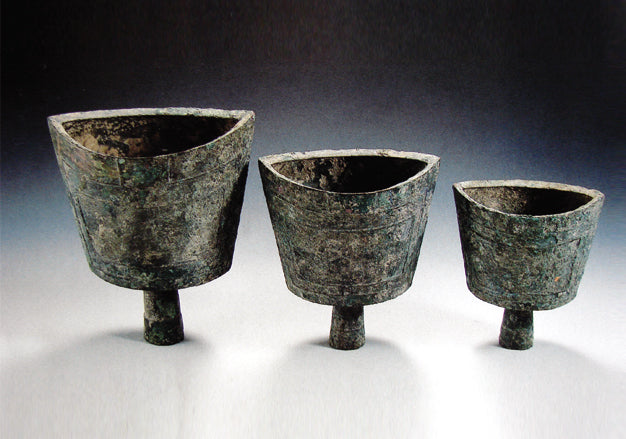
Bronze cymbals with Hui-zigzag pattern

Hui-shaped bronze cymbals, bronze artifacts, Shang Dynasty cultural relics, a set of three pieces, the largest cymbal is 20.5 cm high; the middle cymbal is 17 cm high; the smallest cymbal is 14.5 cm high. Unearthed in Xiaonanzhang Village, Wen County, Jiaozuo City, Henan Province in 1968.
In August 1968, farmers in Xiaonanzhang Village, Chengguan Commune, Wen County, Henan Province, found a batch of bronze artifacts in a pit very shallow from the surface while digging medicinal herbs in the farmland. They immediately reported to the government and took the initiative to hand over this batch of precious cultural relics to the local government.
There are a total of 23 pieces of bronze artifacts unearthed in Wen County, which can be divided into five categories according to their uses: tools, food utensils, wine utensils, weapons and musical instruments [1]. This set of Hui-shaped bronze cymbals is one of the musical instruments. Since the shapes of the jia, jue, gu, ge and other objects in this batch of bronzes are basically the same as those of similar bronzes unearthed from the Yin Dynasty tombs in Gaolouzhuang, Anyang, and the shapes and patterns of other bronzes also have the characteristics of the late Shang Dynasty, experts speculate that the age of this batch of bronzes should belong to the late Shang Dynasty. It was the first time that such a large number of Shang Dynasty bronzes were unearthed in Wen County at that time.

Figure 1 The concave arc-shaped mouth of the bronze cymbals with Huizi pattern
This group of bronze cymbals has a total of three pieces, with decreasing sizes in turn, and the shapes and patterns are consistent. The mouth of the cymbals is upward and concave arc-shaped. The cymbal body is in the shape of a tile. The cross-section of the cavity is broad leaf-shaped, thick-walled, with sharp corners. The milling (the two corners of the upper part of the cymbal) is slightly larger than the milling length, and there is a short tubular handle at the bottom. The short handle is hollow, thicker at the end, thinner at the root of the handle, and the cylindrical empty cymbal (the handle-shaped object at the bottom of the cymbal is called the cymbal) is connected to the cavity.

Figure 2: A short handle with a thin base and thick end for a bronze cymbal with a Chinese character Hui
The three bronze cymbals are decorated with trapezoidal double thick positive string patterns on both sides of the cymbal body. The raised double lines form the Chinese character "回", so they are named "bronze cymbals with a Chinese character Hui", which is a typical Shang Dynasty artifact. As the simplest decoration on bronze ware, the string pattern is composed of a raised straight or horizontal line. Such decoration makes this set of bronze cymbals look simple and plain. Although it has experienced more than 3,000 years of wind and frost, it cannot conceal its unique charm.
After experts measured the sound of the front drum of the bronze cymbals, this set of "bronze cymbals with a Chinese character Hui" was a three-tone gong mode, that is, the mode structure is: gong-jiao-zhi. The discovery of this set of bronze cymbals with a Chinese character Hui provides strong physical evidence and scientific basis for the study of bronze music relics in the late Shang Dynasty in my country, especially the study of bronze cymbals in the area around Yinxu. On the other hand, as important ritual objects buried with the dead in the late Shang Dynasty, these three bronze cymbals fully demonstrate the level of bronze casting and exquisite hand-made craftsmanship in my country at that time in terms of casting technology and shape.

Figure 3 String pattern on the body of the bronze cymbal with Huizi pattern



![8.3"China Shang Dynasty,Bronze wine cup [Fuhao Jue cup][妇好爵杯]](http://bronzc.com/cdn/shop/files/4ee0482982cfa89bb4d1cff3333a55e6_e3ca0b86-22fc-497d-9afd-578c551225a3-2.jpg?v=1733986652&width=533)

![12.8" China Ming Dynasty, Phoenix-patterned bronze vase[Ming Wanli Phoenix-patterned vase][明万历凤纹瓶]](http://bronzc.com/cdn/shop/files/4ee0482982cfa89bb4d1cff3333a55e6_a516991b-2bb9-4b2f-a2b6-4354129d006c.jpg?v=1733986953&width=533)

![14.6" China Eastern Han Dynasty Bronze vessel in the shape of a flying horse,Also known as bronze galloping horse[Horse Stepping on Flying Swallow][马踏飞燕]](http://bronzc.com/cdn/shop/files/4ee0482982cfa89bb4d1cff3333a55e6_aa3fbeb8-e08b-4a44-929a-13411ca8fb17-2.jpg?v=1733987211&width=533)

![5.9"China Tang Dynasty, Bronze of a walking dragon[Tang Walking Dragon][唐走龙]](http://bronzc.com/cdn/shop/files/2_8cb416b9-ebbd-4fe2-a905-b9277f820c16.png?v=1731488701&width=533)
